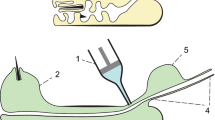Summary
Untreated, decalcified and trypsinized acervuli from human pineal bodies were studied with the scanning and transmission electron microscope as well as by electron probe microanalysis. The mulberry-like acervuli are composed of a various number of spherical lobes (135–800 μm) between which clustered groups of globuli (4–14 urn in diameter) are observed. The acervular lobes are very probably formed by an aggregation of these globuli. Small round particles 125–500 Å in diameter are observed on the surface of the pineal concretions. These are not influenced by either decalcification or trypsin treatment. The acervular mineral corresponds morphologically to hydroxyapatite. The electron probe microanalysis reveals the existence of calcium and phosphorus as main components of the acervuli. Small quantities of magnesium and strontium were also detected.
Similar content being viewed by others
References
Angervall, L., Berger, S., Röckert, H.: A microradiographic and X-ray crystallographic study of calcium in the pineal body and in intracranial tumours. Acta path. microbiol. scand. 44, 113–119 (1958)
Bargmann, W.: Die Epiphysis cerebri. In: Handbuch der mikroskopischen Anatomie des Menschen, Bd. VI/1 (ed. W. v. Möllendorff), pp. 309–502. Berlin: Springer 1943
Döring, F.: Über die sog. Involutionsveränderungen der Epiphysis cerebri. Z. Altersforsch. 5, 66–72 (1944)
Earle, K.M.: X-ray diffraction and other studies of the calcareous deposits in human pineal glands. J. Neuropath. exp. Neurol. 24, 108–118 (1965)
Glimcher, M.J.: Molecular biology of mineralized tissues with particular reference to bone. Rev. Mod. Phys. 31, 359–393 (1959)
McGee-Russel, S.M.: Histochemical methods for calcium. J. Histochem. Cytochem. 6, 22–42 (1958)
Palladini, G., Alfei, L., Appicciutoli, L.: Osservazioni istochimiche sui Corpora arenacea dell'epifisi umana. Arch. ital. anat. embriol. 70, 253–270 (1965)
Wurtman, R.J., Axelrod, J., Kelly, D.E.: The pineal. New York-San Francisco-London: Academic Press 1968
Author information
Authors and Affiliations
Additional information
Dedicated to Professor Berta Scharrer on the occasion of her 70th birthday
With the technical assistance of Mr. P.A. Milliquet
The author wishes to thank Mr. Bauer and Mr. Fryder (Nestec SA, La Tour de Peilz) for the use of the Cambridge Stereoscan electron microscope and Dr. T. Jalanti (C.M.E., Lausanne) for his help with the use of the X-ray microanalyser
Rights and permissions
About this article
Cite this article
Krstić, R. A combined scanning and transmission electron microscopic study and electron probe microanalysis of human pineal acervuli. Cell Tissue Res. 174, 129–137 (1976). https://doi.org/10.1007/BF00222155
Accepted:
Issue Date:
DOI: https://doi.org/10.1007/BF00222155




